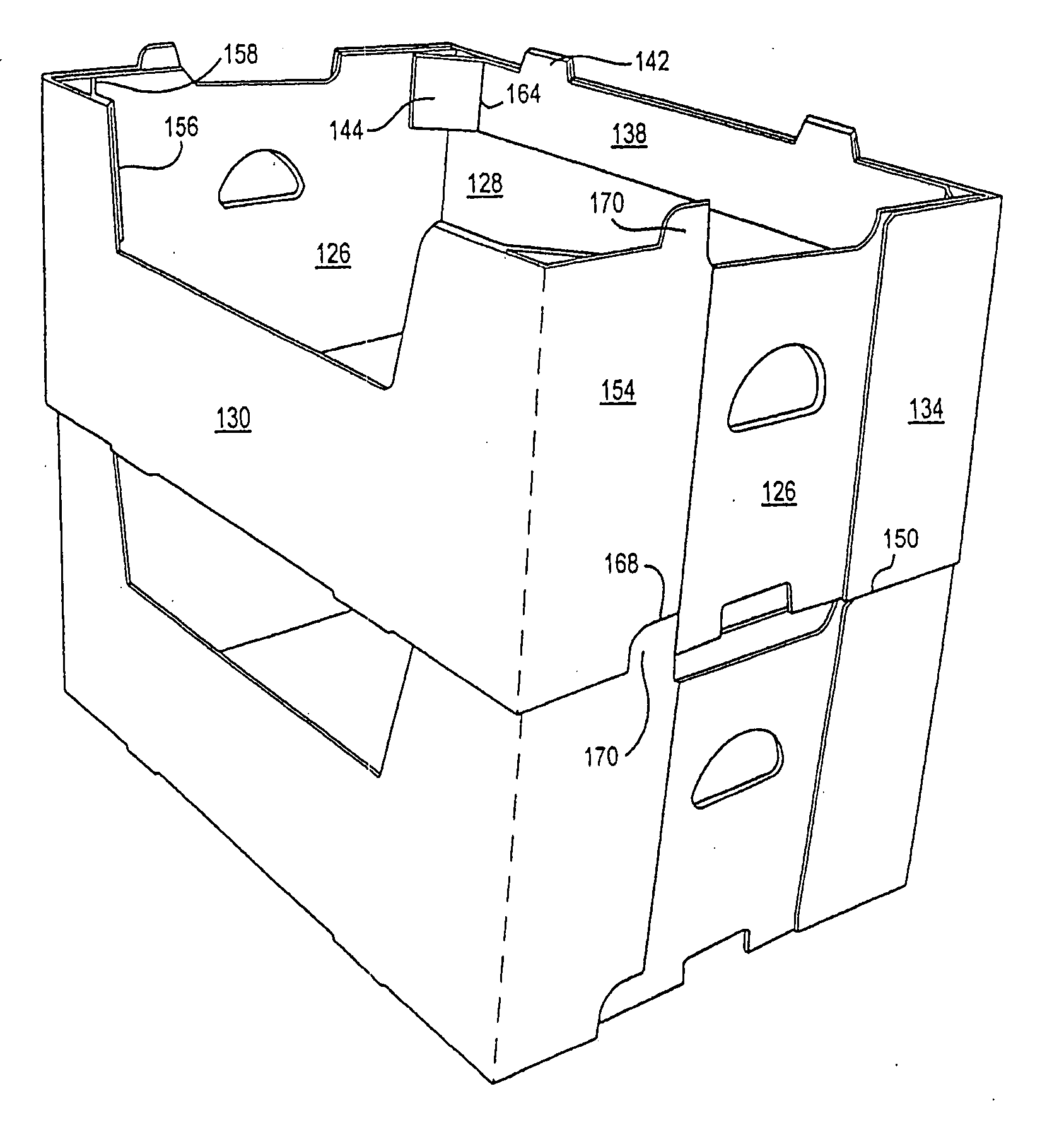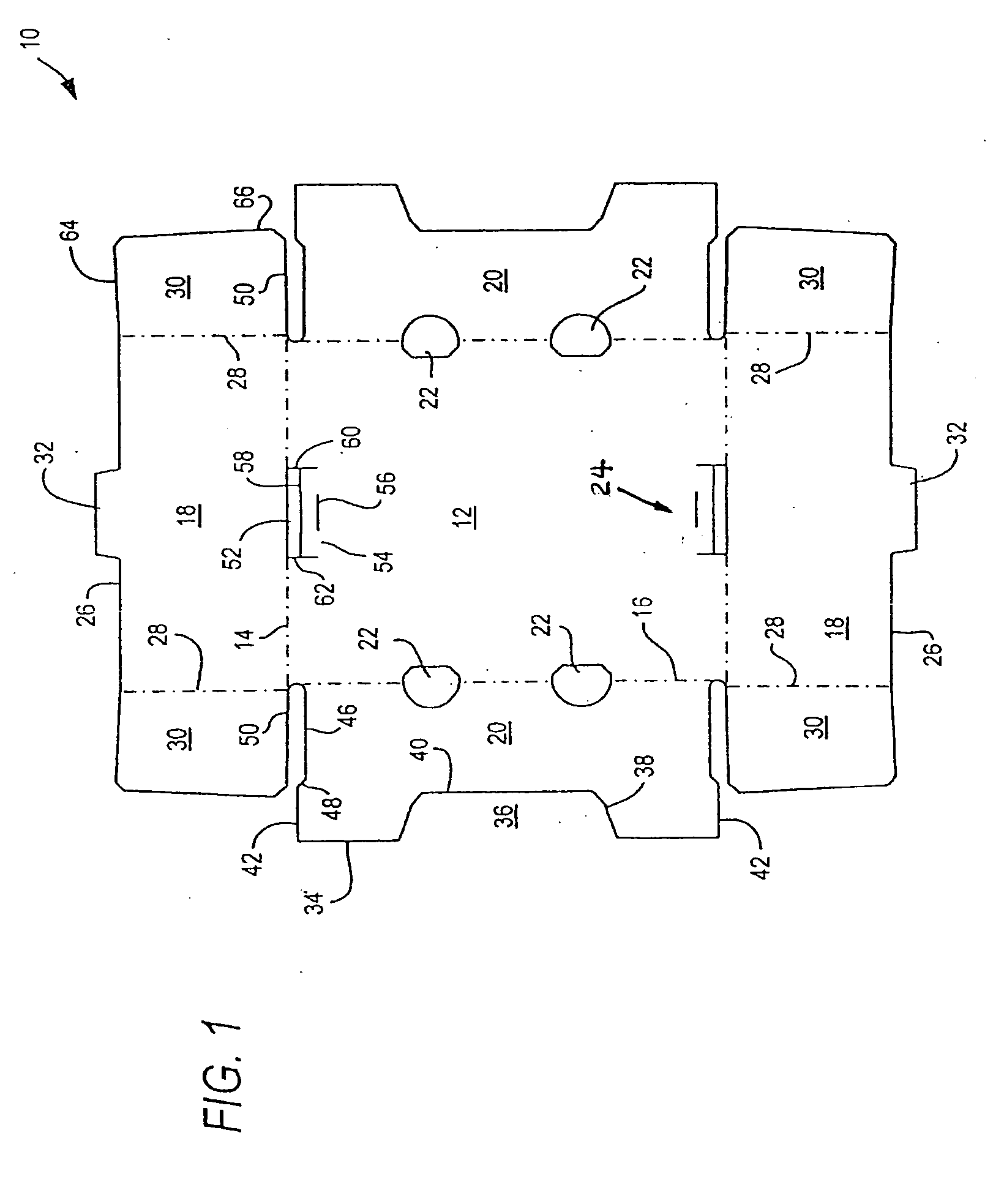Containers with tapered sidewalls and stacking tabs
- Summary
- Abstract
- Description
- Claims
- Application Information
AI Technical Summary
Benefits of technology
Problems solved by technology
Method used
Image
Examples
first embodiment
[0028] A paper or paperboard blank scored in accordance with the invention is shown in FIG. 1. Blank 10 is scored for the purpose of folding into a container suitable for holding, shipping or stacking a wide variety of objects, such as perishable agricultural products. The blank can be made of any material known in the art that is suitable for the shipping and transporting of a wide variety of food items, and preferably is a flat sheet of corrugated paper or paperboard. Different thicknesses of material can be used for packaging heavier products.
[0029] Base panel 12 is a substantially rectangular panel bordered by end fold lines 14 and side fold lines 16. End panels 18 foldably connect to base panel 12 along fold lines 14, and side panels 20 foldably connect to base panel 12 along fold lines 16. The base, end and side panels correspond to the bottom (or base), end, and sidewalls of a container erected from the blank. As such, the terms “panel” and “wall” are used interchangeably her...
second embodiment
[0039]FIG. 2 shows a second embodiment, wherein the sidewalls and the corresponding stacking tabs on the sidewalls are tapered. Base panel 68 is a generally rectangular panel bordered on four sides by end fold lines 98 and side fold lines 100. End panels 72 and side panels 78 and 94 are foldably connected to base panel 68 along fold lines 98 and 100, respectively. Further, the bottoms of end panels 72 contain notches 76 that partially extend into the base panel, traversing fold line 98, and locks 102 are cut out of base panel bordering fold lines 100.
[0040] Side panel 78 is a generally rectangular panel that corresponds to at least one sidewall when the container is fully erected. Accordingly, the length of side panels 78 in blank 70 corresponds to the height of the sidewall when the container is erected. In the present example, the length of the side panel is 9 11 / 16 inches, but the exact length can vary widely within the spirit of the invention. Each side panel 78 is bordered on f...
third embodiment
[0048] the container is seen in FIG. 3. Here, a narrow reinforcement flap 138 is added to the top of sidewall 128 to reinforce the sidewalls and stacking tabs and to create a partial top structure or larger top ledge on the top portion of the sidewalls to enhance stackability. The reinforcement flap is a long, thin band of flexible material similar in width to the sidewalls, but considerably shorter in length than the sidewalls (i.e., extending over only a small portion of the height of the sidewall), thereby requiring less material and lowering production costs. The reinforcement flap further comprises small corner flaps or corner posts 144 foldably attached along opposing fold lines 164 on the reinforcement flap's opposite ends, and at least one tab reinforcement 142 integrally attached to the reinforcement flap along one of its longer edges. Sidewall 128 of FIG. 3 is similar to sidewall 78 in FIG. 2. Specifically, tapered sidewall 128 is bordered by a side fold line 124, two oppo...
PUM
 Login to View More
Login to View More Abstract
Description
Claims
Application Information
 Login to View More
Login to View More - R&D
- Intellectual Property
- Life Sciences
- Materials
- Tech Scout
- Unparalleled Data Quality
- Higher Quality Content
- 60% Fewer Hallucinations
Browse by: Latest US Patents, China's latest patents, Technical Efficacy Thesaurus, Application Domain, Technology Topic, Popular Technical Reports.
© 2025 PatSnap. All rights reserved.Legal|Privacy policy|Modern Slavery Act Transparency Statement|Sitemap|About US| Contact US: help@patsnap.com



